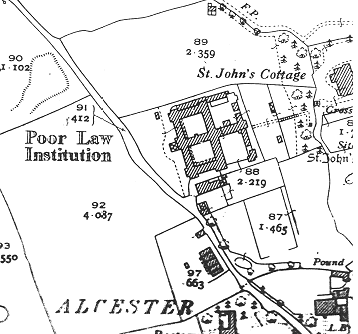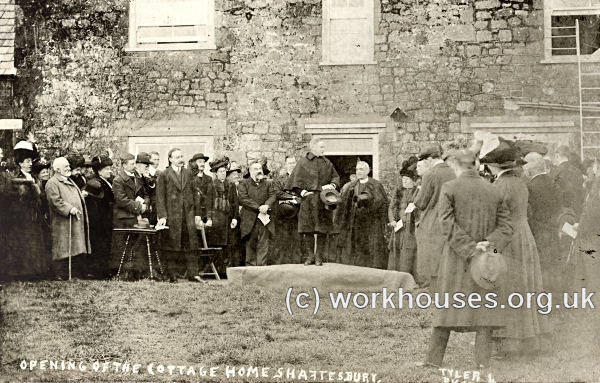Shaftesbury, Dorset
Up to 1834
In 1697, following the example of Bristol in the previous year, Shaftesbury successfully promoted a private Act of Parliament (9 & 10 William III, c.48) for the "construction of workhouses and houses of correction for better employment and maintenance of the poor." Little appears to be known of any workhouse that was subsequently constructed. A parliamentary report of 1777 listed a parish workhouse in operation at Gillingham for up to 70 inmates, but none in Shaftesbury (or "Shaston" as it was listed).
At the start of the nineteenth century, poor relief in Shaftesbury seems to have suffered from severe underfunding. By now, Shaftesbury had two parish poorhouses although the conditions for the inmates left much to be desired. One contemporary account relates that "On the whole, the appearance of the inmates was marked by extreme poverty and filth, and the place has long been notorious as a scene of particular wickedness". (Rutter, 1819)
After 1834
Shaftesbury Poor Law Union formally came into existence on 12th October 1836. Its operation was overseen by an elected Board of Guardians, 23 in number, representing its 19 constituent parishes as listed below (figures in brackets indicate numbers of Guardians if more than one):
Dorset:
Ashmore, Compton Abbas, Fontmell Magna, Gillingham (2), Iwerne Minster, Margaret Marsh, Melbury Abbas, Motcomb [Motcombe] (2), East Orchard, West Orchard, Shaston St Rumbold alias Cann, Shaftesbury—Holy Trinity (2), Shaftesbury—St James, Shaftesbury—St Peter (2), East Stour, West Stour, Stour Provost, Sutton Waldron, Todber.
Later Additions (all from 1894): Alcester, Bourton, Buckhorn Weston, Kington Magna, Shaftesbury, Silton.
The population falling within the union at the 1831 census had been 13,869 with parishes ranging in size from Margaret Marsh (population 86) to Gillingham itself (2,520). The average annual poor-rate expenditure for the period 1833-35 had been £8,882 or 14s.6d. per head of the population.
In 1836, the Poor Law Commissioners authorised the union to spend up to £4,000 on the building which was to accommodate 250 inmates. Work began on the building the same year, at a site in the Castle Hill area as the south-west of the town. Continuing difficulties in financing the construction hampered progress, however, and during this period workhouse accommodation was provided by the former parish workhouses at Gillingham and Motcombe. In 1838, a further expenditure of £2,000 was approved and the new building finally opened in 1840. The building was designed by William Walker and was based on the Poor Law Commissioners' model "square" plan published in 1835. The site location and layout are shown on the 1929 map below, by which time it was known as Shaftesbury Poor Law Institution.

Shaftesbury site, 1929.
After 1930, the workhouse became Shaftesbury Public Assistance Institution. The building was demolished in 1947.
Cottage Home
In January 1912, the Shaftesbury Union opened a children's cottage home. The following year, an arrangement was made with the Sturminster Union, wherebey the Shaftesbury home would be used to house the girls from both unions while Sturminster would provide one for all the boys. The Shaftesbury cottage home had closed by 1919.

Shaftesbury Union Cottage Home opening, 1912.
© Peter Higginbotham
Staff
Inmates
Records
Note: many repositories impose a closure period of up to 100 years for records identifying individuals. Before travelling a long distance, always check that the records you want to consult will be available.
- Dorset History Centre, Bridport Road, Dorchester DT1 1RP. Relatively few records survive. Holdings include: Guardians' minute books (1835-40, 1883-1930); Ledgers (1903-30); etc.
Bibliography
- (Rutter, 1819) A Brief Sketch of the State of the Poor in Shaftesbury by John Rutter (1819)
- Dorset Workhouses Countryside Treasures Survey (Dorset County Council, 1979).
Links
- None.
Unless otherwise indicated, this page () is copyright Peter Higginbotham. Contents may not be reproduced without permission.


